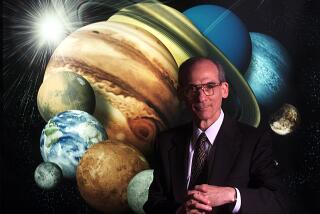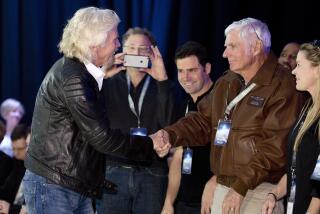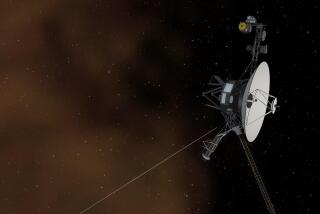A Beacon in Cosmos
At the far reaches of our solar system, amid the emptiness of solar wind and cosmic rays, are two tiny markers of humanity’s dream to reach to the stars.
Voyagers 1 and 2, the intrepid spacecraft originally launched in 1977, have traveled more than 14 billion miles, visited four planets and surveyed dozens of moons. And they are still flying.
For the record:
12:00 a.m. Aug. 14, 2002 For The Record
Los Angeles Times Wednesday August 14, 2002 Home Edition Main News Part A Page 2 ..CF: Y 4 inches; 174 words Type of Material: Correction
Voyager--A Monday Science File story about the 25th anniversary of the launch of Voyager 1 and 2 misspelled the name of a systems engineer on the project. The correct spelling is Tim Hogle.
*
In the next few weeks, the twin Voyagers will celebrate their 25th year in space. Voyager 1 is now the most distant human-made object in the universe, with Voyager 2 close behind.
Originally built to last five years, the spacecraft have been so successful that scientists extended their missions. Now bound for interstellar space, the Voyagers will endure for 20 more years, until their power is spent and human contact with the spacecraft is no longer possible.
“Twenty-five years is a tremendously long time but is still only a little past the half-way point of what the spacecraft is capable of,” said Tim Hogul, a Voyager systems engineer and mission director who has been working on the project for 24 years.
The missions began Aug. 20, 1977, with the launch of Voyager 2, followed by the launch of Voyager 1 on Sept. 5. The first 25 years of the twin spacecraft have revolutionized the understanding of the solar system.
“Voyager showed us that the solar system is more diverse than anyone imagined--the magnetic fields, rings, moons and winds are all different,” said Ed Stone, project scientist of the Voyager mission since 1975 and previous director of NASA’s Jet Propulsion Laboratory.
Stone is still amazed at Voyagers’ flood of discoveries:
Scientists now know that moons are very active, he said. There are hot volcanoes on Jupiter’s Io and icy volcanoes on Neptune’s Triton. “There is more volcanic activity on Jupiter’s little moon than here on Earth,” he said.
The spacecraft discovered that the great red spot on Jupiter is actually an enormous storm. The solar system’s fastest winds are on Neptune. And Titan, a moon of Saturn, is smaller than we thought, made to look deceptively large by a haze of organic smog raining down on its surface.
Two decades past their original lifetime, some may think the Voyager spacecraft are past their prime. But they have proved to be remarkably resilient. Their new mission to the edge of the solar system may bring a new wealth of astronomical data.
The Voyagers will likely be the first spacecraft to explore beyond the limits of the sun’s influence.
Voyager is currently flying within the bubble of solar wind created by the sun’s atmosphere. Inside the bubble, also known as the heliosphere, all material comes from our sun. Outside the bubble is interstellar space, swirling with particles from exploded stars.
As the solar wind approaches the heliopause--the boundary of the bubble--it must slow down from speeds of a million miles per hour to about 250,000 mph, Stone said. This abrupt change is the termination shock. The Voyagers should reach the termination shock in just a few years.
Ten to 12 years after the shock, both probes will pass through the heliopause, about 5 to 14 billon miles from the sun.
During their race to interstellar space, Voyagers 1 and 2 will collect data on the sun’s magnetic field, solar wind particles and interstellar cosmic rays, said Ed Massey, the current project manager on the Voyager mission.
After passing through the heliopause, the craft can then sample the environment outside the heliosphere--”We can find out what kind of galactic particles carry from other stars,” Stone said.
But for now, the spacecraft fly steadily on. “The warranty is over, and they’re working well,” Massey said.
Voyagers 1 and 2 are so far way--7.96 billion miles and 6.31 billion miles from the sun, respectively--that a command signal sent at the speed of light to Voyager 1 takes almost 12 hours to reach its target.
In comparison, a signal to a spacecraft orbiting Mars takes 15 minutes.
Massey’s team must make special considerations for such delayed communication, and have even orchestrated spacecraft repairs from billions of miles away. But he doesn’t view this as the program’s biggest challenge. “It’s keeping a team together to operate Voyager as long as we can,” he said.
Massey works with a current operating team of 12 people, compared with 600 in the mission’s heyday in 1977. Funding cuts could reduce the team’s numbers even more, so scientists may have to look at new and riskier ways to cut costs, Massey said.
The operation budget isn’t the program’s only dwindling resource. Energy generated by the Voyagers’ plutonium power source is in steady decline.
As the power decreases, different instruments are turned off and scientific capabilities of the spacecraft diminish.
The Voyagers’ slow progression to old age started in 1990, when most imaging instruments were shut down.
Voyager 2 had one last hurrah, as it turned around toward Earth to take a “family photo” of the solar system.
In about 10 years, their primary orientation mechanisms will be turned off. The spacecraft will then have to rely on the sun sensor and star tracker to orient toward Earth, Massey said.
And about 10 years after that, about 2020, Voyagers will no longer have enough power to operate their instruments and will stop sending data back to Earth.
At this point their interstellar mission will end, but what then?
“The Voyagers can drift forever, whether they have power or not,” Stone said.
In about 40,000 years, Voyage 1 will come within 1.6 light-years (9.3 trillion miles) of a star in the constellation Camelopardalis. “This will be the first time Voyager is nearer another star than they are to the sun,” Stone said.
And 250,000 years later, Voyager 2 will pass Sirius, the brightest star in our sky, at a distance of 4.3 light-years (25 trillion miles).
Each spacecraft carries a gold-plated copper disc with greetings, music and 115 images, including the Golden Gate Bridge, the Great Wall of China, rush hour on an Indian highway and a human fetus.Tim Hogul, who has worked with the Voyagers so long that he views the spacecraft as his children, sees the project as a time capsule of our generation.
“Voyager is a beacon for mankind into the cosmos,” Hogul said, “lasting well past the fate of Earth.”






